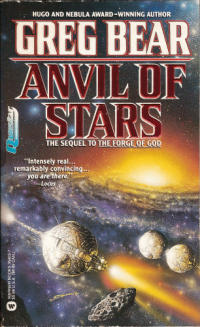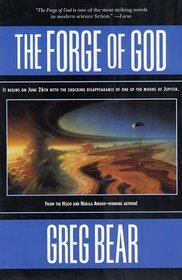Eon by Greg Bear
 Saturday, October 14, 2017 at 10:49AM
Saturday, October 14, 2017 at 10:49AM 
First published in 1985; republished as part of The Eon Series by Open Road Media on May 16, 2017
Eon is the middle novel of a trilogy, although the first to be written. The others are its prequel and sequel. It is an ambitious, challenging novel that many consider to be Greg Bear’s finest work.
The sighting of the Stone, which turns out to be an asteroid containing seven chambers, raises some interest, as it was preceded by the sighting of a supernova in the same line of sight. It soon becomes apparent that there was no supernova. The Russians have also spotted the Stone but they call it the Potato. Humans of all nations eventually wonder whether the Stone Potato is an alien artifact. They investigate, only to determine that the asteroid is familiar, even if its contents are not, and that it seems to have been hollowed out by humans.
Patricia Vasquez is sent to the Stone because she is the world’s leading (and perhaps only) authority on non-gravity bent geodesics. Perhaps she can explain the tunnel that seems to stretch a vast distance from the seventh chamber — a much longer distance than the Stone itself. But more pressing than the puzzle of physics is the puzzle presented by the library, which contains a printed volume from the future recounting a past that seems to coincide with Earth’s present. The scientists are pretty sure the history relates to a different universe, but if it is parallel to Earth’s own, the Earth’s nations will soon annihilate nearly all life on the planet.
Also on the Stone, although unknown to the humans who traveled from Earth to study it, is someone named Olmy who traveled a much longer distance to return to the place he lived as a boy. Some of the novel’s characters meet Olmy on a journey of their own.
A good bit of the novel focuses on political conflict between the United States and Russia, which not only threatens the Earth’s destruction but the Stone’s when Russia decides to invade and occupy it. The conflict becomes a compelling subplot when Russians and Americans realize they don’t have much to fight about any longer, and when some of the mysteries of the Stone are revealed to them. At that point, a rather more complex political struggle emerges, one that doesn’t much involve Americans or Russians, although it will be of great consequence to them.
Politics is also at the heart of the novel’s imagined (alternate) future, in which Ralph Nader became sort of an icon who sparked a movement that coexists, largely in conflict, with other political groups. The humans in the (alternate) future developed a language that relies in part on graphic symbols, suggesting that Bear anticipated the widespread use of emoticons before they became popular. Other notable aspects of the future humans are their ability to download memories and personalities into a central computer, where they enjoy indefinite “life” after using the two natural lifespans in a human body to which they are legally entitled. Most new humans, however, are not created in the customary (fun) way, but by merging personalities in the computer banks and assigning the result to an artificially created body. Again, Bear was a bit ahead of his time, if not a pioneer, in envisioning the role of transhumanism or posthumanism in science fiction.
And I haven’t even mentioned the aliens and the role they play in the (alternate) future political conflicts. The downside of including so many themes and ideas (I’ve only touched on some of the most important) in a single novel is that some of them seem dashed off or thrown away. The novel’s other fault is that Bear’s description of things and events are difficult to visualize while political structures, although central to the novel, are underdeveloped. The science is jargon-heavy, which resolute fans of hard sf seem to appreciate, but members of a general audience who (like me) have academic training in areas other than science might find some of his more esoteric concepts a bit baffling. The story in this lengthy and almost unmanageable novel sometimes bogs down, simply because the universe in which it is set almost becomes overwhelming. Still, Eon is an impressive work, and a testament to Bear’s creativity.
RECOMMENDED


